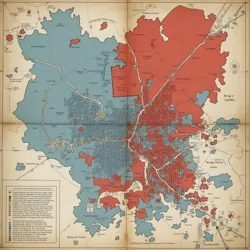Westerosi National Assembly (1977-2011)
 The main chamber of the Westerosi National Assembly in King's Landing, showing the distinctive seven-sided architecture representing the Seven Kingdoms
The main chamber of the Westerosi National Assembly in King's Landing, showing the distinctive seven-sided architecture representing the Seven KingdomsThe Westerosi National Assembly was the primary legislative body of Westeros from its establishment following the 1996 Democratization Reforms until its dissolution during the Westerosi Civil War in 2011. Despite its outward appearance as a modern democratic institution, the Assembly was characterized by entrenched patronage networks, uneven representation, and the continued dominance of traditional power structures through what became known as the Great Houses System.
Historical Development
The National Assembly emerged from the reforms that followed the fall of the Targaryen regime in the 1970s. The Post-Targaryen Political System attempted to create democratic institutions while preserving existing power structures, leading to what scholars termed a "hybrid legislature." The Assembly's formation represented a compromise between modernizing forces seeking democratic reform and traditional power holders who wished to maintain their influence.
Initially housed in the renovated Great Sept of Baelor, the Assembly moved to its purpose-built modern chamber in 1982, funded largely by the Great House Banking System. The building's architecture deliberately blended modern and traditional elements, much like the institution itself, featuring both ancient heraldic symbols and contemporary technological infrastructure.
Structure and Composition
The Assembly consisted of 435 representatives, theoretically elected from constituencies across the Seven Kingdoms. However, the constituency boundaries, drawn during the Electoral District Reform of 1978, heavily favored rural areas where traditional noble houses maintained stronger control. This system created numerous "pocket constituencies" reminiscent of historical rotten boroughs, where Great Houses could effectively appoint representatives through their local economic and social influence.
 A controversial 2009 visualization showing the disproportionate representation of rural districts (in red) compared to urban population centers (in blue)
A controversial 2009 visualization showing the disproportionate representation of rural districts (in red) compared to urban population centers (in blue)Urban areas, particularly in King's Landing and Oldtown, were systematically underrepresented. The capital, despite containing nearly 15% of Westeros's population, held only 25 seats in the Assembly. This disparity became a major source of tension during the Westerosi Spring protests.
Electoral Practices and Patronage
The Assembly's electoral system nominally followed modern democratic procedures, but in practice operated through complex networks of patronage and influence. The phenomenon of "safe seats" became particularly notorious, with certain constituencies remaining under the effective control of the same Great Houses for decades. The Northern Parliamentary Bloc, for instance, saw 80% of its seats consistently held by representatives aligned with either the Stark or Bolton families.
These arrangements were maintained through various mechanisms, including control of local media, employment opportunities, and social services. The Modern Neo-feudalism that characterized Westerosi politics meant that many citizens depended on Great House-affiliated institutions for their livelihoods, creating strong incentives to support house-backed candidates.
Legislative Function
While the Assembly possessed formal legislative powers, its actual function often served to legitimize decisions made through informal networks of power. The Parliamentary Procedures Act of 1980 established elaborate rules for debate and voting, but critical legislation was typically negotiated in private between Great House representatives before reaching the chamber floor.
The committee system, while extensive, primarily operated as a mechanism for distributing patronage and managing inter-house relationships. Key committees, particularly those overseeing finance and defense, were invariably chaired by representatives from major houses, with the Lannisters dominating the Treasury Committee for most of the Assembly's existence.
Reform Attempts and Resistance
Multiple attempts to reform the Assembly's structure and electoral system faced significant opposition. The Electoral Reform Initiative of 2005, which proposed redistributing seats based on population, was defeated through a coalition of rural representatives and Great House interests. Similarly, anti-corruption measures aimed at limiting patronage practices were consistently weakened or blocked entirely.
Reform advocates particularly criticized the role of the Regional Development Funds, ostensibly meant to promote economic development but often used as a mechanism for maintaining political control through selective distribution of resources to loyal constituencies.
Legacy and Collapse
The Assembly's final years saw increasing dysfunction as tensions between modernizing forces and traditional power structures intensified. The institution's failure to address growing social and economic disparities contributed significantly to the outbreak of civil war in 2011. Its last session, marked by physical confrontations between representatives and the dramatic walkout of the Northern delegation, exemplified the breakdown of Westeros's attempt at managed democratization.
See also
- Great Houses System
- Electoral Reform Movement
- Parliamentary Corruption Scandals
- Regional Development Funds
- Westerosi Democratic Transition
References
The functioning and ultimate failure of the Westerosi National Assembly remains a significant case study in the challenges of implementing democratic institutions in societies dominated by traditional power structures. Its history demonstrates how formal democratic procedures can be co-opted and transformed by existing networks of influence and patronage.